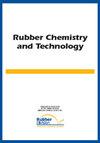研究弹性断裂与温度和速率的关系
IF 1.5
4区 工程技术
Q4 POLYMER SCIENCE
引用次数: 0
摘要
Thomas和Smith几十年来对弹性断裂现象的研究表明,橡胶在较低温度下更坚固。普遍的解释将断裂行为与聚合物粘弹性联系起来。鉴于最近的见解和证据表明韧性是由强度决定的,我们从不同的角度研究弹性断裂,并得出结论,链断裂决定了断裂特征,包括其温度依赖性。在选定的温度范围内,当拉伸速率低于0.17 s-1时,拉伸被证明是完全弹性的。我们证明,托马斯和史密斯观察到的强度和韧性的温度和速率依赖关系仍然发生在我们的交联聚丁二烯(BR)和丁苯橡胶(SBR)中。温度对强度和韧性速率依赖性的影响比WLF位移因子aT的影响要大得多。此外,无论是在逐步拉伸或蠕变过程中,裂纹在较低温度下以较低的速度扩展,这无法用聚合物弛豫动力学来解释。我们的新解释是,碳碳键在较低的温度下更强,也就是说,由于可用的热能与温度T成正比,共价键在张力下解离所需的时间更长。本文章由计算机程序翻译,如有差异,请以英文原文为准。
Investigating dependence of elastomeric fracture on temperature and rate
Decades of elastomeric fracture phenomenology due to Thomas and Smith demonstrated a remarkable fact that rubbers are stronger and tougher at lower temperatures. The prevailing explanation relates the fracture behavior to polymer viscoelasticity. Given the recent insight and evidence that toughness is determined by strength, we examine elastomeric fracture with a different perspective and conclude that chain scission dictates fracture characteristics including its temperature dependence. Working within a selected temperature range, stretching is shown to be entirely elastic at stretching rate below 0.17 s-1, we demonstrate that the same temperature and rate dependencies of strength and toughness, observed by Thomas and Smith, still occur in our crosslinked polybutadiene (BR) and styrene-butadiene rubber (SBR). The temperature effects on rate dependence of strength and toughness are found to be much stronger than that prescribed by the WLF shift factor aT. Moreover, crack propagates, upon either stepwise stretching or during creep, at a much lower speed at lower temperature that cannot be rationalized with polymer relaxation dynamics. Our new interpretation is that a carbon-carbon bond is stronger at a lower temperature, equivalently, it takes a longer time for a covalent bond to undergo dissociation in tension because available thermal energy is proportional to temperature T.
求助全文
通过发布文献求助,成功后即可免费获取论文全文。
去求助
来源期刊

Rubber Chemistry and Technology
工程技术-高分子科学
CiteScore
3.50
自引率
20.00%
发文量
21
审稿时长
3.6 months
期刊介绍:
The scope of RC&T covers:
-Chemistry and Properties-
Mechanics-
Materials Science-
Nanocomposites-
Biotechnology-
Rubber Recycling-
Green Technology-
Characterization and Simulation.
Published continuously since 1928, the journal provides the deepest archive of published research in the field. Rubber Chemistry & Technology is read by scientists and engineers in academia, industry and government.
 求助内容:
求助内容: 应助结果提醒方式:
应助结果提醒方式:


